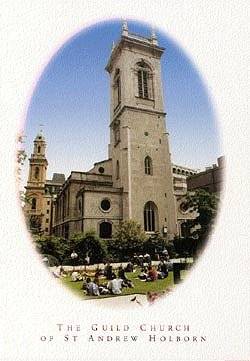
This is an enterprising series of concerts in the current Italian Festival
99, the most ambitious celebration of Italian culture ever presented in the
British Isles. The RCO is making its presence felt in St Andrew's Church,
its new City of London home by Holborn Viaduct, with regular series of recitals
given by internationally famous and by up and coming organists.
The first two recitals in this series were given by the veteran Luigi Ferdinando Tagliavini, an authority on Frescobaldi, and the younger Francesco Cera from Bologna, a versatile performer and conductor, who has recorded the complete works of Rossi and Merula. Both artists played on a small chamber organ placed at the front of the nave, as well as on the multi-purpose Mander 1989 organ in the gallery of St Andrew's. The Goetze & Gwynn positive organ was a charming little instrument which has featured in recordings of Italian music, based on a 17th C. instrument in Lucca, with two stops and pedal pulldowns. Its placement in the church made for more immediacy in the relationship between performer and listeners, often a problem for organ recitals.
On 5 November Tagliavini played pieces by Frescobaldi, Merula and Pasquini on the chamber organ in the first half of his programme, upstairs afterwards Albinoni, Scarlattis (Alessandro & Domenico) and a Vivaldi concerto transcribed for organ by J S Bach. The following morning he demonstrated his vast knowledge of early Italian keyboard music in a workshop with RCO students, discussing the complex issues needing to be considered in reaching true interpretations. He encouraged greater freedom and brilliance, demonstrating wrist action to articulate repeated notes. He gave great attention to the tempi relationships between different sections, beginning adagio and creating increasing vivacity, sometimes slowing the beat to get the effect of acceleration, "like a car going through the gears, the motor goes slower but the car goes faster". Chromatic passages should be emphasised and they invite slower tempo; you should exploit differences between major and minor, abandon strict tempi for free cadences at the ends of sections, then a tempo again. Tagliavini's English was good but, for the audience, audibility was a problem and the sound system did not seem to be working properly when everyone migrated upstairs to the gallery for lessons on Vivaldi/Bach concertos.
Francesco Cera's programme was devoted to the Neapolitan Baroque, music in which extravagant dissonance, chromaticism and gesture were prominent. In addition to the two organs played by Luigi Tagliavini, Cera had at his disposal a beautifully decorated single-manual Ransom/Hammett harpsichord based on Grimaldi instruments of around 1700. He moved easily and frequently from one instrument to another. This was all enjoyable, extrovert music in which virtuosity could be enjoyed for its own sake. In the first half we heard lesser known composers including Trabaci, Strozzi and de Macque (a riotous Capriccio played on the large instrument with blaring brass stops) and later there were some delightful 18th century sonatas by Pergolesi and Domenico Scarlatti, and a setting by Allesandro Scarlatti of the ubiquitous Follia with 29 increasingly exciting variations.
CDs: Tagliavini has a CD of similar repertoire on Fone 90F33 and Cera is represented on Tactus TC700002 (Venetian sonatas). review
Remaining events in this enterprising series include a recital and lecture/workshop by Nicolas Kynaston, and a concert to celebrate Italian influence on British music with choir and organ (17 to 19 November). Details from italy@rco.org.uk
Peter Grahame Woolf
 Return to:
Return to: